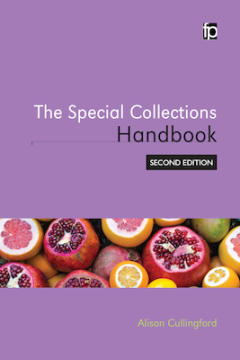
Additional Information
Book Details
Abstract
This comprehensive and no-nonsense guide to working with special collections and rare books is an essential day-to-day companion.
Working with special collections can vary dramatically from preserving a single rare book to managing and digitizing vast mixed-media archives, yet the role of the information professional is always critical in tapping into the potential of these collections, protecting their legacy and bringing them to the attention of the wider public. This book offers up-to-date guidance which pulls together insights from best practice across the heritage sector to build innovative, co-operative and questioning mind-sets that will help them to cope in turbulent times.
The Handbook covers all aspects of special collections work: preservation, developing collections, understanding objects, emergency planning, security, legal and ethical concerns, cataloguing, digitization, marketing, outreach, teaching, impact, advocacy and fundraising.
New to this edition:
- coverage of new standards and concepts including unique and distinctive collections (UDCs), The Leeds Typology, Archive Accreditation, PD 5454:2012 and PAS 197
- discussion of the major changes to laws affecting special collections including UK copyright law relating to library/archive exception and orphan works and forthcoming changes to data protection in the EU
- exploration of new trends in research including the rise of digital humanities, open access, the impact agenda and the REF
- updates to the sections on marketing, audience development and fundraising to include social media, customer journey mapping and crowdsourcing and more
- consideration of impact and indicators, digitization and new skills frameworks from CILIP and RBMS.
This is the essential practical guide for anyone working with special collections or rare books in libraries, archives, museums, galleries and other heritage organizations. It is also a useful introduction to special collections work for academics and students taking library and information courses.
This new second edition includes: coverage of new standards and concepts including unique and distinctive collections (UDCs), The Leeds Typology, Archive Accreditation, PD 5454:2012 and PAS 197; discussion of the major changes to laws affecting special collections including UK copyright law relating to library/archive exception and orphan works and forthcoming changes to data protection in the EU; exploration of new trends in research including the rise of digital humanities, open access, the impact agenda and the REF; updates to the sections on marketing, audience development and fundraising to include social media, customer journey mapping and crowdsourcing and more; and consideration of impact and indicators, digitization and new skills frameworks from CILIP and RBMS. Simply stated, it is thoroughly 'user friendly' in organization and presentation, making it certain that all libraries and library systems should have a copy of The Special Collections Handbook in their professional instructional reference collections.
Library Bookwatch
This comprehensive and no-nonsense guide to working with special collections and rare books is an essential day-to-day companion. Working with special collections can vary dramatically from preserving a single rare book to managing and digitizing vast mixed-media archives, yet the role of the information professional is always critical in tapping into the potential of these collections, protecting their legacy and bringing them to the attention of the wider public. This book offers up-to-date guidance which pulls together insights from best practice across the heritage sector to build innovative, co-operative and questioning mind-sets that will help them to cope in turbulent times. The Handbook covers all aspects of special collections work: preservation, developing collections, understanding objects, emergency planning, security, legal and ethical concerns, cataloguing, digitization, marketing, outreach, teaching, impact, advocacy and fundraising. New to this edition: - Coverage of new standards and concepts including unique and distinctive collections (UDCs), The Leeds Typology, Archive Accreditation, PD 5454:2012 and PAS 197 - discussion of the major changes to laws affecting special collections including UK copyright law relating to library/archive exception and orphan works and forthcoming changes to data protection in the EU - exploration of new trends in research including the rise of digital humanities, open access, the impact agenda and the REF - updates to the sections on marketing, audience development and fundraising to include social media, customer journey mapping and crowdsourcing and more - consideration of impact and indicators, digitization and new skills frameworks from CILIP and RBMS. This is the essential practical guide for anyone working with special collections or rare books in libraries, archives, museums, galleries and other heritage organizations. It is also a useful introduction to special collections work for academics and students taking library and information courses.
The Special Collections Handbook should be an essential tool to anyone managing Special Collections or archives, no matter their professional background or area of expertise.
Mark Dorrington
The University of Nottingham
Archives and Records
Alison Cullingford is Special Collections Librarian at the University of Bradford, where she is responsible for over 100 collections of modern archives and rare books. The service was the first English university to achieve Archive Accreditation. She also managed the Unique and Distinctive Collections project for Research Libraries UK. An active member of the CILIP Rare Books and Special Collections Group and many other sector groups, Alison also regularly presents at conferences, blogs and tweets on the importance of the special collections librarian.
As a practical handbook, this volume should be on the shelf of every special collections library – it should, indeed, be on the shelf of every library. There is much that all librarians may glean from it, whether their institution houses a special collection or not. It is worth every information professional understanding how special collections work to facilitate organizational communication and understanding, to see whether there are opportunities for collaboration or simply to understand how special collections function within a wider institution.
Ludovica Price
University of London
Reference Reviews
Highly recommended for practitioners and faculty seeking a real-world manual for special collections courses.
Betty J. Glass
University of Nevada Library
Library Journal
